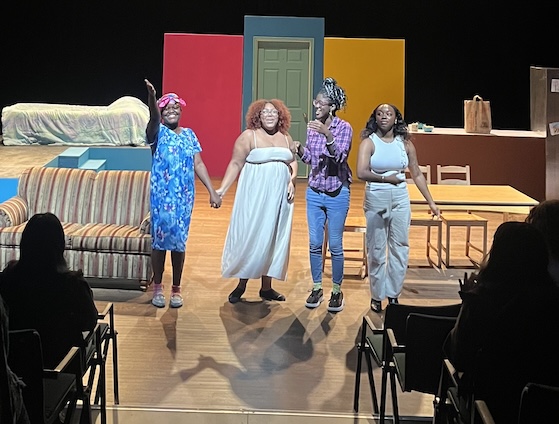
c/o Celeste McKenzie
“How Black Mothers Say I Love You” opened in the Patricelli ’92 Theater on Friday, Oct. 11, marking the start of student theater on campus for Fall 2024. The play, written by Canadian playwright Trey Anthony, explores themes of motherhood, religion, and grief. Claudette (Oluchi Chukwuemeka ’25) returns to her childhood home in Brooklyn to visit her ailing mother Daphne (Shekinah Mba ’26) and must confront the pain of their shared past.
Director Celeste McKenzie ’27 hoped that her production would expose its audience to a perspective that is often overlooked by the campus’s largely white theater community.
“To read a play for Black women written by a Black woman was incredibly emotional for me,” McKenzie wrote in a message to The Argus. “More than anything, I’m happy that I get to showcase Black talent on a campus where I feel that it is generally underrepresented, and I hope to educate white audiences about the experiences of many Black immigrants in this country and to cultivate a culture of empathy toward experiences we may not directly relate to.”
In the first scene of “How Black Mothers I Love You,” the tension between Claudette and her mother is immediately clear. Daphne vacillates between giving her estranged daughter updates about their relatives and church friends and chiding her about how long it has been since she last visited. Mba effectively channeled an authentic Caribbean mother, delivering Daphne’s thinly-veiled jabs at her daughter to hearty laughter from the audience while maintaining the character’s stern, tenacious persona.
Soon after, the audience meets Claudette’s younger sister, Valerie (Monique Peters ’28), who has remained close to home in her adulthood, dutifully caring for their mother since she got sick. As the story unfolds, Valerie anxiously tries to keep the peace between her mother and sister as they quarrel about Daphne’s abandonment of the girls in Jamaica as children, Claudette’s estrangement, and the family’s most taboo subject: Claudette’s sexuality. Peters’ thoughtful portrayal of Valerie presents an upbeat character whose bubbly facade masks her internal conflict as she balances her mother’s care with her own grief surrounding her failing marriage and recent miscarriage.
While the family tries to resolve their differences, another figure literally haunts the stage, wordlessly walking into scenes and interacting with some characters while staying invisible to others. During a conversation between Claudette and Val, the audience learns that the figure is the ghost of their youngest sister, Cloe (McKenzie), who died of a childhood illness. Cloe, whose legacy is a constant point of contention between Claudette and her mother, intermittently joins the cast on stage, silently reaching out to Daphne, as if asking her to join her in eternal rest.
Meanwhile, Claudette grapples with her own feelings of abandonment and struggles to respect her mother’s grief as she recalls how Daphne got married and gave birth to Cloe after leaving her and Valerie behind. Chukwuemeka’s depiction of Claudette’s internal struggle is the beating heart of the production. She personifies the process of learning how to love and accept love from someone who has hurt you, a transformation that is neither simple nor linear.
Ultimately, “How Black Mothers Say I Love You” presents a close look at the complex lives of a Black immigrant family, asking the audience to hold empathy for each character rather than seeing anyone as a clear hero or villain.
“I think something I struggled with a lot is trying to assign ‘good’ or ‘bad’ to any of these characters and that is simply not the reality,” Mckenzie wrote. “This show is about how sometimes the people that we love don’t love us in the way that we want to be loved…. I would hope that people walk away from the show with more empathy for Black immigrants and their experiences and, rather than agreeing with any of their actions, can begin to understand the context behind it.”
McKenzie also emphasized that supporting the artistic efforts of students of color at a predominantly white institution is vitally important to ensuring that students of color continue to present their art, even when the subject may make viewers uncomfortable.
“I want to acknowledge the difficulty that may be presented in white audiences going to see a play that is uniquely about the Black experience,” McKenzie wrote. “There should be more of a willingness to be uncomfortable [on this campus]. A willingness to be wrong. A willingness to listen. I think a lot of the students of color on campus just want to feel heard, and that’s what having your art consumed is: to be listened to.”
Sulan Bailey can be reached at sabailey@wesleyan.edu.
1 Comment
Gail
Wonderful piece. Loved seeing this book on stage. The ladies really nailed the performance.